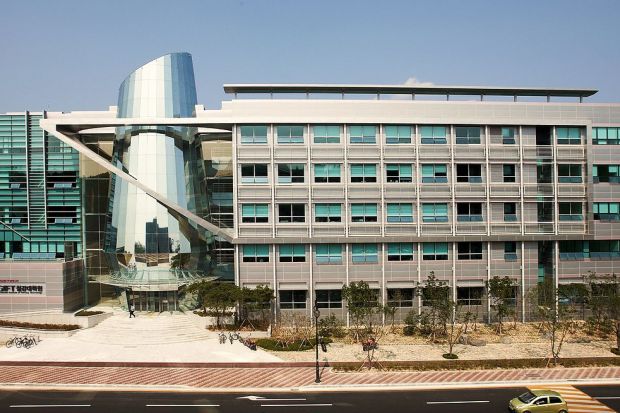POSTECH: The Origin of Bifurcated Current Sheets Explained
A Korean research team has identified the origin of bifurcated current sheets, considered one of the most unsolved mysteries in the Earth’s magnetosphere and in magnetized plasma physics.
A POSTECH joint research team led by Professor Gunsu S. Yun of the Department of Physics and Division of Advanced Nuclear Engineering and Dr. Young Dae Yoon from the Pohang Accelerator Laboratory has theoretically established the process of collisionless equilibration of disequilibrated plasma current sheets.*1 In addition, by comparing this with particle simulations and satellite data from NASA, the origin of the bifurcated current sheets – which had remained largely unknown – has been revealed.
In the Earth’s magnetosphere, a sheet-shaped plasma is observed that is trapped between two regions of opposing magnetic fields. Because current flows inside it, it is also called a current sheet. According to the conventional theory, the current sheet exists as a single bulk in which the magnetic pressure due to the magnetic field generated by the current and the thermal pressure of the plasma balance one another, thereby forming an equilibrium. However, in 2003, the European Space Agency’s Cluster mission observed a bifurcated current sheet in Earth’s magnetosphere. Since then, similar phenomena have been
observed.
On the other hand, extensive research has been accumulated on the condition in which the magnetic force and thermal pressure are perfectly balanced with each other in the current sheet. But the process through which a disequilibrated current sheet equilibrates remains largely unknown. Since plasma systems generally do not start from an equilibrium state, comprehension of the equilibration process is desired to better understand the current sheet plasma dynamics.
The joint research team thoroughly analyzed the process in which the disequilibrated sheet achieves equilibrium by considering the orbit classes and phase-space distributions of particles that constitute the current sheet and found that the current sheets can naturally bifurcate during the equilibration process. It was then confirmed that these theoretical predictions were consistent with the particle-in-cell simulation results performed by the KAIROS supercomputer*2 at the Korea Institute of Fusion Energy. In addition, the simulation data were compared and verified with NASA’s Magnetospheric Multiscale (MMS)*3 measurements.
This achievement has enhanced the comprehension of magnetized plasma dynamics by incorporating theoretical analyses, supercomputer simulations, and satellite observations. Since the Earth’s magnetospheric plasma has similar characteristics as other magnetized plasmas such as nuclear fusion plasmas in various ways, it is anticipated to contribute to a wide range of fields.
“This study has a significant academic value in that it simultaneously resolved two mysteries: the process through which disequilibrated current sheet equilibrates and the origin of bifurcated current sheets,” explained Professor Gunsu S. Yun of POSTECH who participated as a co-corresponding author in the study. “We are trying to extend the analysis framework for plasmas with strong guide fields and hope to understand similar phenomena that occur in fusion plasmas.”
Supported by the National Research Foundation of Korea, this study was published in Nature Communications on June 18, 2021.
1. Plasma current sheet
Plasma, the fourth state of matter in which atomic nuclei and electrons are separated and freely moving, occupies 99.9% of the universe. The material present in the Earth’s magnetosphere is also plasma. The state in which plasma exists in the form of a sheet where the current flows in a direction horizontal to the sheet is called a current sheet. In this current sheet, the magnetic resistance – caused by the magnetic field produced by the current – and the thermal intensity caused by the heat and density of the plasma act in opposite directions. When the magnitude of the force is perfectly equal to each other, it is called the equilibrium state. When it is not perfectly equal, it is called a disequilibrated state.
2. KAIROS at the Korea Fusion Energy Research Institute
KAIROS is a supercomputer built at the Korea Fusion Energy Research Institute in 2020 and has the performance of 1.56 petaflops, which is equivalent to the performance of 3,300 Intel i7-9700K desktop PCs. It is the largest supercomputer designated for a specific research area, and the third largest supercomputer housed by a public institution in Korea after KISTI and the Korea Meteorological Administration. It was built for fusion energy plasma simulations.
3. NASA MMS satellite, USA
The Magnetospheric Multiscale (MMS) satellites are a group of satellites launched by NASA in 2015 to study the Earth’s magnetosphere. Four identical satellites orbit the Earth in a tetrahedral configuration, equipped with equipment to observe a variety of variables such as electromagnetic fields, currents, or particle distribution. Research is still actively conducted on magnetic field recombination, turbulence, and high-energy particles occurring in the Earth’s magnetosphere using data obtained from MMS.

